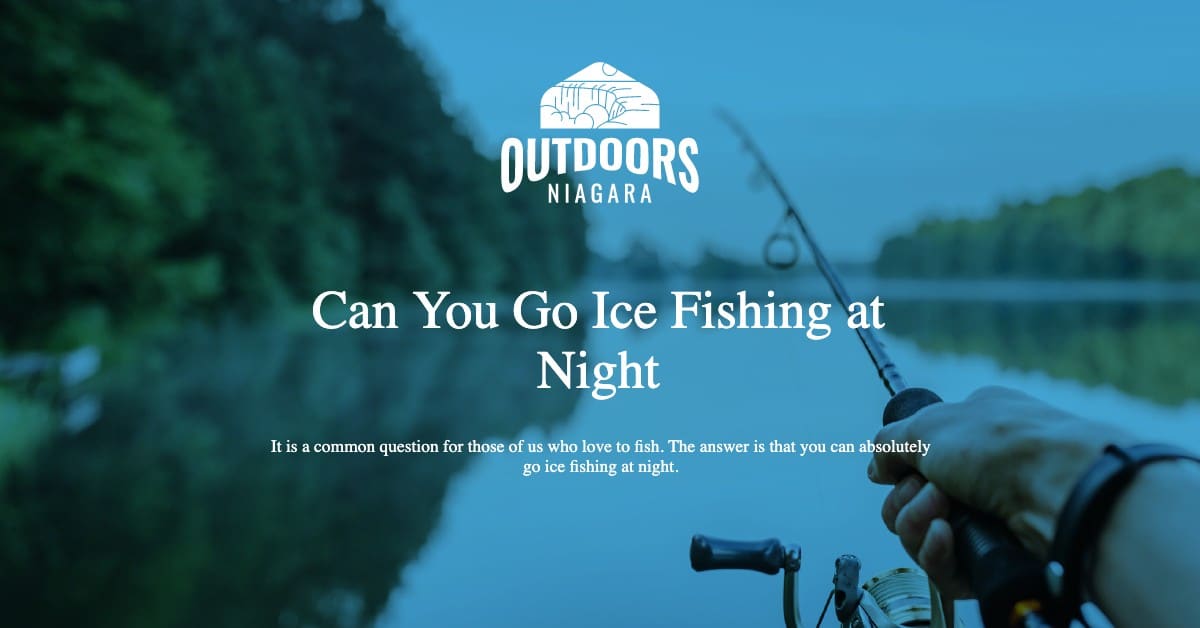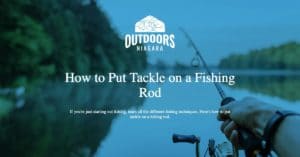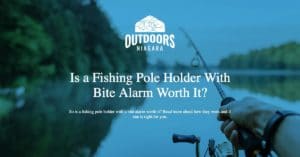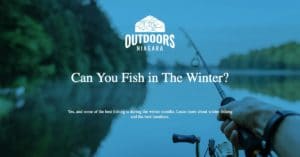So, can you go ice fishing at night? It is a common question for those of us who love to fish. The answer is that you can absolutely go ice fishing at night, and you can do so successfully.
While many species of fish are active at night, you will have to target those species and leave some others for daytime fishing.
Two species that are active at night include Walleye and Crappie as both have excellent night vision.
If you are hoping to target trout, bass, bluegill, or northern pike, you will struggle.
These fish have poor night vision. If you plan to target bluegill, trout, pike, or bass at night, you will need to do so during a full moon with an ice fishing rod and when there is plenty of light hitting the ice.
If you think about the habits of fish that have good night vision, you begin to see a pattern.
Most will leave the deeper water and head to the shallower areas where the weedy beds are to hunt for smaller fish, aquatic insects, and plant matter.
That process begins about an hour before sunset, and it can continue throughout the night.
However, for most night-feeding fish, there are two periods in the night where the feeding is most intense – Dawn and Dusk.
If you decide to ice fish at night you need to set up your hut early to avoid all the noise of drilling holes, and moving your hut.
That noise will startle fish away from where you want to fish.
By setting up your site early and then leaving it alone for several hours, the fish will return, and you will have more success as you fish at night.
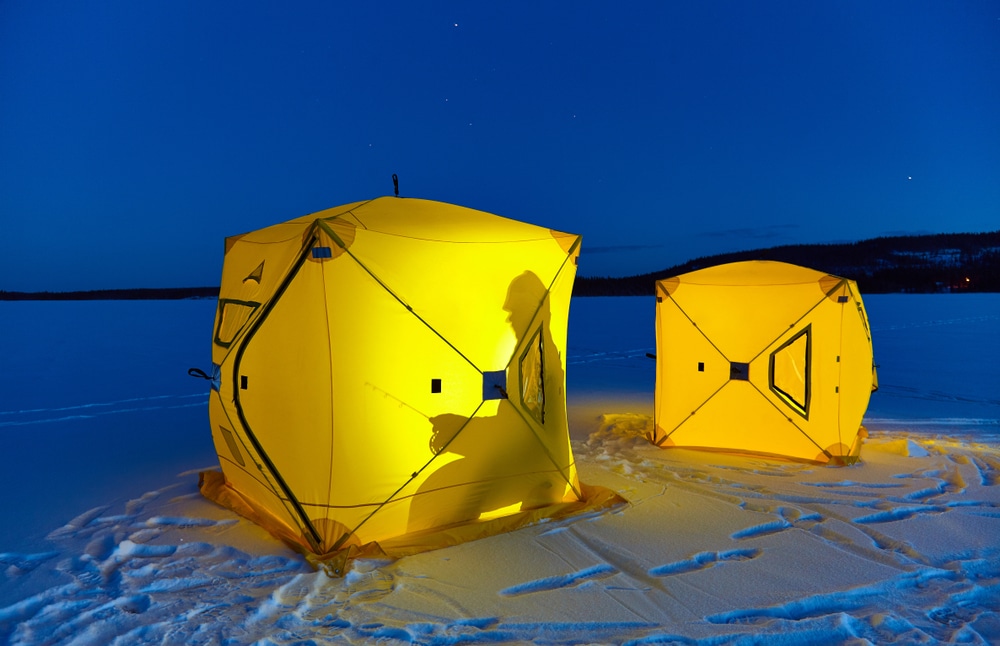
Contents
So, Can You Go Ice Fishing at Night?
Ice fishing at night is a growing sport. There are many reasons why people ice fish at night.
These include better access to certain types of fish that may not be as active during the day.
There is also the fact that there is less fishing pressure at night, so you can often choose the best fishing locations.
Another good reason to ice fish at night is the fact that you can do so locally or out in the wilderness.
If you set up your hut to be warm and dry, you can even camp on the ice.
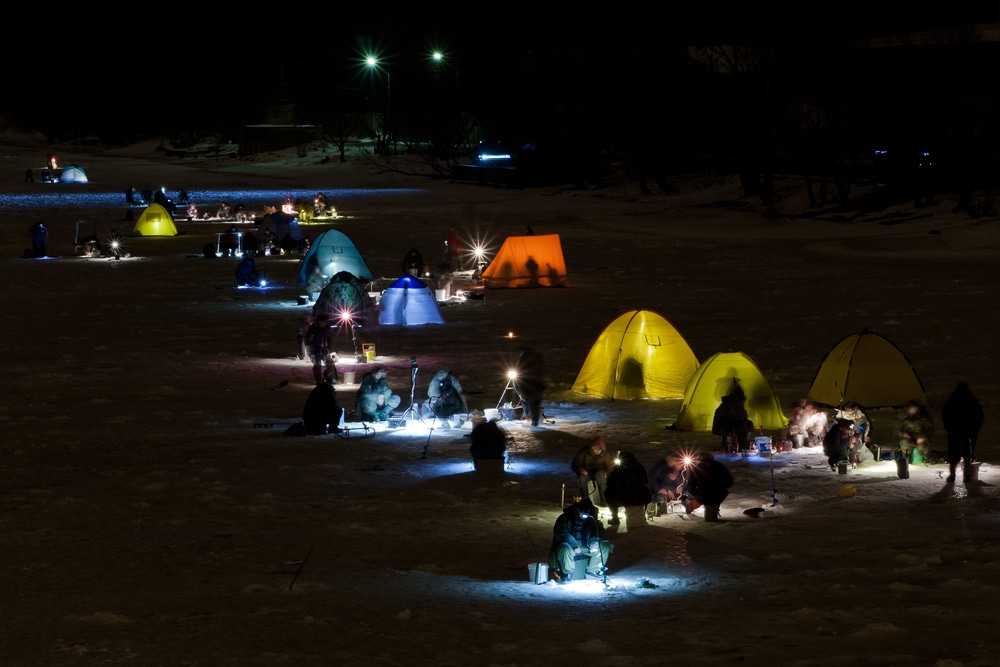
Reasons Why to Go Ice Fishing at Night
Some anglers prefer not to ice fish at night. One reason is that you need to use different types of lighting to see.
Using a white light or flashlight, you can startle the fish, and they will not bite.
It can also be difficult to find someone to go with you, especially if you are new to fishing.
Many anglers like to fish in the daytime, but staying up all night can be challenging.
It can also be expensive to get all the gear you need to ice fish safely at night.
You will need an auger, a shelter, and warm clothing that will stand up to getting wet and the winter cold.
If you don’t have the proper gear to ice fish at night, the experience can be miserable.
A final reason why people do not like to go ice fishing at night is that it can be scary to be on the ice at night in winter.
Best Night Fishing Locations
Generally, the best night fishing locations are along the shore.
When you set up your night ice fishing spot you want to have the option to fish from 3-5 feet deep to around 10-15 foot depths.
What happens at night for predatory fish is that they emerge from the deeper water to hunt in the shallows.
Crappy and walleye have very good night vision.
They can swim slowly through the cover looking for smaller fish, aquatic insects, and plants that they may consume.
The bonus for these fish is that their prey often cannot see them.
Smaller fish often use weed beds to hide.
For example, in the summer, when the ice is gone and the water is warmer, you can drag a rodent pattern fly or lure over the top of a shallow weed patch and set your hook into a 50-inch northern pike that is lurking in the shallows.
You can also do that while you fish on the ice with a jig.
While pike is generally a daytime target, you can find big predatory fish in the shallows at night that are very active.
If you choose your spot well, you can haul in crappie all night long.
If you are fishing on a lake that has walleye you can hit them all night long too.
The best location for night ice fishing is from 3-feet-15 foot depths along the shore.
This band of water offers a few advantages. First, it is shallow, so it will hold more light than deeper water.
It is also full of smaller fish that larger fish will feed on through the night.
Because you are not that far out on the ice, you can set up an on-shore camp if you are fishing for the weekend and allow your fishing spot to remain inactive until you start to fish.
Doing so will help settle the fish and allow them to get on with hunting for food.
Species Best Fished At Night
The two best species to target at night are crappie and walleye.
Both have excellent night vision and similar hunting habits.
They are also very plentiful making them the go-to targets for anglers who want to ice fish at night and have a lot of fish action.
There are other species of fish that you can target at night.
One of the biggest fishes you may encounter while ice fishing at night is big, fat, catfish.
You will have to prepare to deal with fish as large as catfish which can easily top twenty pounds.
One trick to attract catfish at night is to use a lure or bait that glows in the dark.
Catfish have poor eyesight, but they may investigate subtle lights.
When you fish for crappie or walleye, you can use lures or baits.
When you target fish that have poor night vision, you can use bait.
They may not see a lure, even a bright orange one, but they can follow a scent trail left by your bait.
Catfish are often deep and on the bottom.
They like to hide in structures and those are the types of areas you want to look for if you target catfish at night on the ice.
A fourth target you can ice fish at night is carp.
Carp fishing can be very difficult under the ice, but you can target carp, which are also active at night.
You will need a fish finder that will show you where the carp are.
Most often, carp swim in schools, so once you located where the fish are, you can target them with baits.
Carp mostly feed by following their noses and one of the best baits you can use is sweet corn.
Stinky baits are ideal, and you will need to rig them up to handle big fish.
If you think catfish can get big, then consider battling a 40-pound carp through the ice.
What Depth Do You Ice Fish at Night?
The sweet spot for ice fishing at night is anywhere between 3-15 foot depths.
Most ice anglers will drill two holes in the ice and fish in the shallows and where the shallow water meets the drop-off.
In a lake, that is the spot where the water begins to deepen quickly.
This area of the lake or river is often where the baitfish and shads are and those two sizes of fish are prime food for larger fish.
In the daytime, many fish hang out in the deeper water where the water temperature is more consistent.
The shallow water can be colder in the winter during the daytime depending on the weather.
At night, those fish with better night vision will leave the depths and forage in the shallow waters for food.
Small fish, aquatic insects, some crustaceans, and other food types are all found in the shallower waters and often within weed patches or among structures, such as rocks.
Does Light Attract Fish to Ice Fishing?
Using light to attract fish is a tactic that anglers use, and it works even for ice fishing.
Some fish see well at night and others do not.
Bass and Trout are not very good at finding food at night simply because their eyes are not made for seeing in darker waters.
Walleye and Crappie are two fish that see very well at night and are easier to target while ice fishing at night.
When you add a light to your ice fishing setup, you can attract many types of fish, even those that do not feed at night.
The reason is that light attracts all members of the food web.
It starts with the zooplankton, which attracts the minnows, which then attracts the shads, and then the larger fish.
Because of the added light available, even species of fish that do not see well at night will investigate the light and feed on the available food around the light.
If you do not want to attract fish to your ice holes at night, you use a red light, which they do not see very well.
It will allow you to see but will not startle the fish.
A bright white light will attract most types of fish to your spot.
Light can be a good deal for anglers, but it can also be a problem.
Some fish are startled by the light and will leave the area.
Using light at night to ice fish is one of those tactics that you should try and see if it works for you.
A better tool is to use a fish finder with sonar that will show you where in the depths the fish are resting.
That information will allow you to make an informed decision about where to set up your ice hut and fishing spot.
Using a light means you are bringing the fish to you, which may or may not work.
Using a fish finder with sonar will allow you to find the fish and then set up your fishing spot where the fish already are located.
Ice Fishing at Night Tips
- Safety First – Always fish with a buddy when you ice fish in the daytime or at night. Cold water is deadly and if something should happen, you cannot wait for help to find you.
- Choose Your Fishing Spot Wisely – The best areas to fish are in the shallow waters near structures such as weed patches. You can use a fish finder to help you find where the fish are in deeper water and then set up your fishing location in the adjacent shallows.
- Plan Your Trip – There are two types of ice fishing adventures – those that are planned and those that are not. When you plan an ice fishing adventure, especially at night, you search for the best location, use sonar and fish finders to find the fish, and the habitat, and target specific types of fish – crappie, and walleye, etc. You set your camp up early and then you fish as the sun sets and again as the sun rises. When you do not plan your trip, you may not know where the fish are, what kind of habitat is beneath the ice, or what kind of fish are available.
- Focus on Comfort – Ice fishing at night is cold and sometimes wet. A portable fishing hut will shelter you from the elements and can be equipped with heating to keep you warm and relaxed. It is miserable to fish when you are cold and wet.
- Target Fish that See Well At Night – Crappy and Walleye are two examples. Target them by choosing lures or baits that they will like. Orange, chartreuse, yellows, and vibrant pinks are examples. Fish with night vision also see contrasts well, so include a few white or black lures too.

